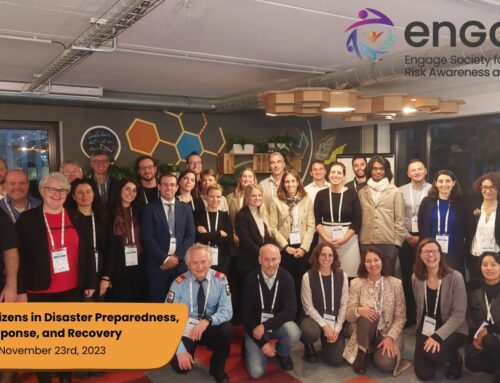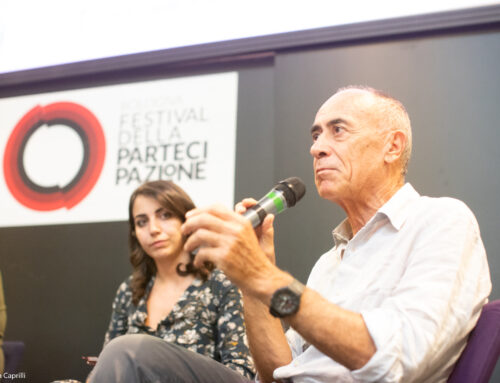International recommendations provided in the United Nations Sustainability Goals and the SENDAI framework emphasize the value of public participation in all phases of disaster management activities (from preparedness to learning from events) in order to build more resilient societies. But how do organizations leading these activities, such as authorities and emergency organizations, go about this? How do they identify potential approaches or event specific tools to better involve populations under their responsibility? Can they, for instance, look at innovative and successful approaches in other areas and directly apply them in their location? Can they, also, recognize and better support local initiatives that emerge from the population’s own efforts? The answer is, of course: it’s complicated. But these are the questions project ENGAGE aims to answer over the course of its 3-year span.

The primary objective of ENGAGE is find solutions to involving civilian populations in disaster management and describe the conditions necessary for their successful implementation. We use the term solutions in a broad sense: it encompasses tools, methods, practices, procedures, and strategies.
The approach that we adopt in ENGAGE is based on understanding the specificities of a given location. We consider that the most effective solutions will necessarily be related to how societal resilience manifests in a given location. We ask, for example, what makes certain solutions viable in one local context but not (or only partially so) in another? To make the link between the solutions and societal resilience, we first consider what elements of the local context are factors that support or hinder societal resilience.
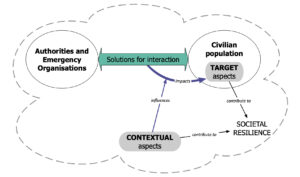
Here a distinction is helpful: on one hand, there are aspects of society on which one can act upon directly (e.g., income level) – these are target aspects; on the other hand, there are aspects that are part of the local context and cannot easily be changed (e.g., culture) – these are contextual aspects. This distinction between target and contextual dimensions allows us to state the underlying idea of the project: a solution aims to have an impact on a population, but its impact is influenced (positively or negatively) by the context of use. This idea can be illustrated using an example of solution from the current COVID-19 situation.
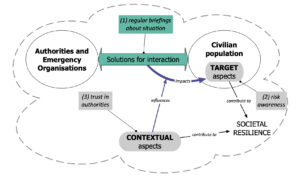
Most countries around the world have implemented some form of regular briefings about the situation (1). The ways in which briefings are carried out varies (e.g., regularity, content), but the main objectives are usually to keep the population informed about rates of infection, recommendations, and vaccination progress. In other words, such a solution aims to increase the population’s risk awareness (2). We investigate in the project how such awareness in a population is indeed related to societal resilience. But the success and impact of such communication vary, though, in part due to contextual factors such as trust in authorities (3), an aspect that is typically associated to societal resilience. Such trust is usually described as cultural (varying across countries, cultures and communities) but can also be related to a particular moment in a location’s history (e.g., specific government in place). In any case, while risk awareness in the population is indeed something authorities might try to improve directly (i.e., target), increasing trust in authorities might be a longer-term objective and is difficult, if not impossible, to address directly. Interestingly, the distinction between target and contextual aspects is not always so sharp.
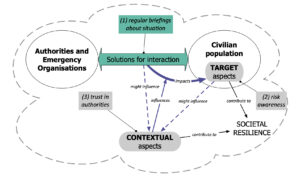
Over time, improvements in target aspects might translate into improvement in contextual aspects; and solutions, while more targeted in certain regards, might indirectly aim to impact contextual aspects. For instance, using our current example, establishing better communication practices between authorities and the population in times of crisis might, in the end, improve trust in authorities.
These are the kinds of factors of societal resilience, solutions for involving the public and complex dynamics, that ENGAGE aims to investigate. The project aims to improve knowledge by identifying and relating such elements and dynamics, and to improve practices by providing enriched descriptions of solutions that authorities and emergency organizations can implement to better support societal resilience in local contexts. In the end, a solution involving a population in disaster management might be successful in one location but only be implementable elsewhere under some conditions. The overall ideas discussed here, which underly the work in ENGAGE, provide a path to understand why such a solution might be successful and how sensitive it is to its context of use.
Authors: Matthieu Branlat, Asbjørn Lein Aalberg, Martina Ragosta (SINTEF)


